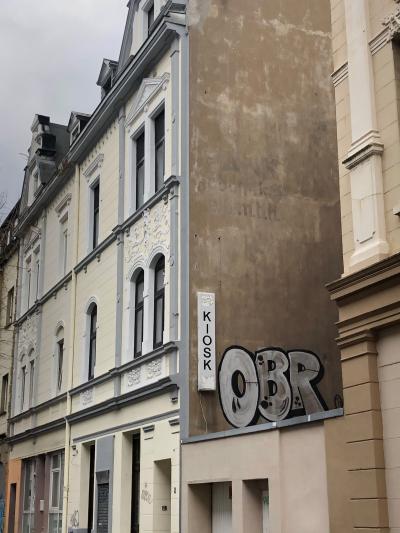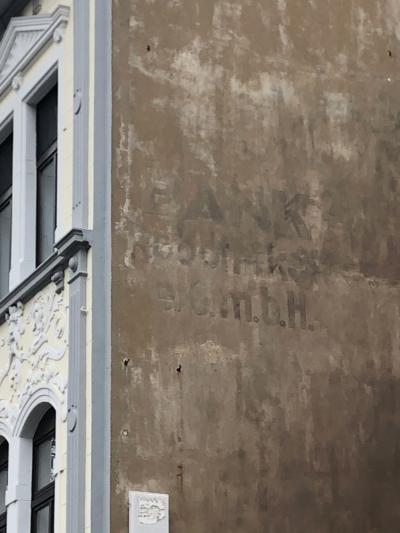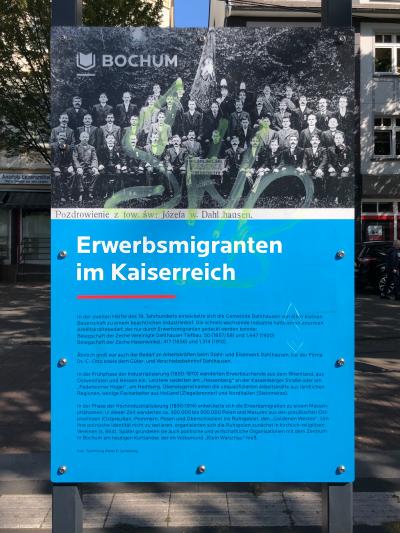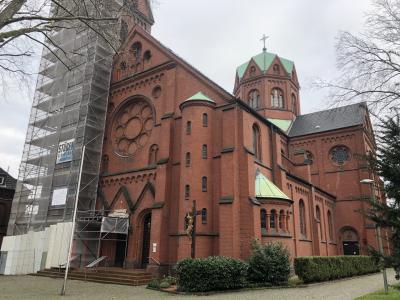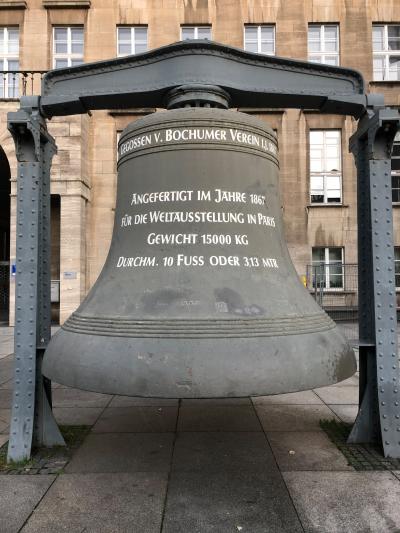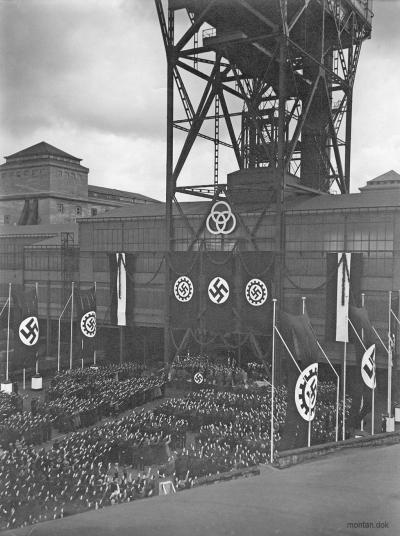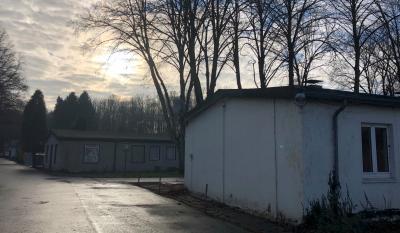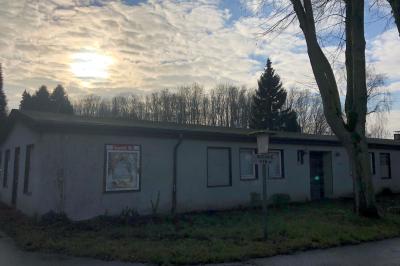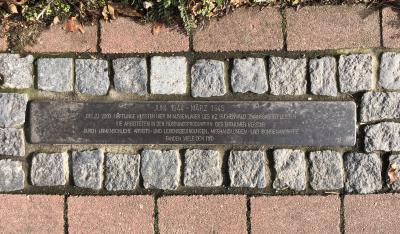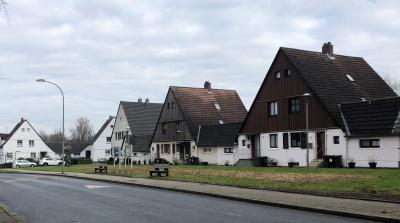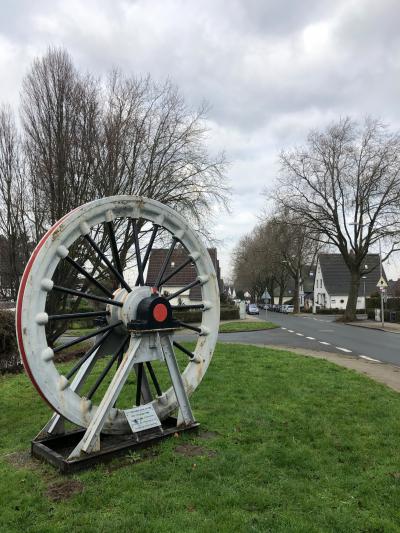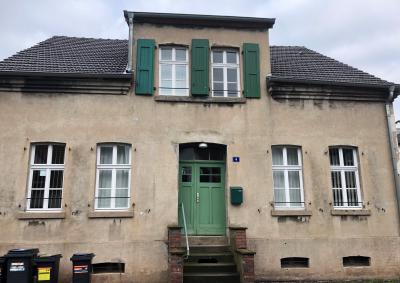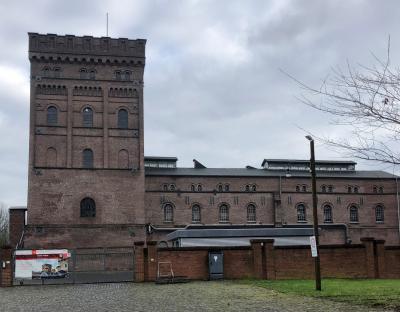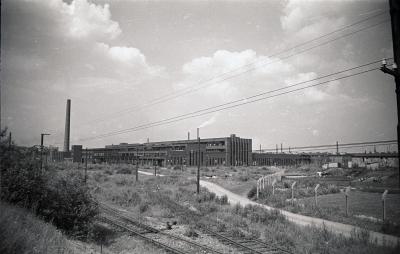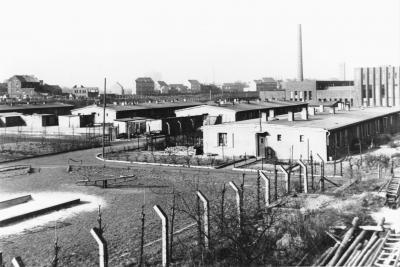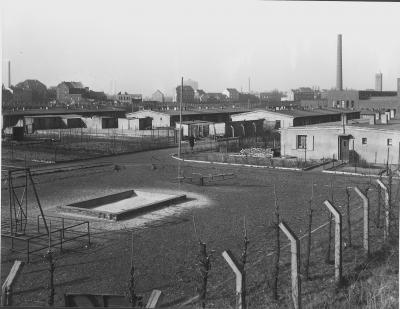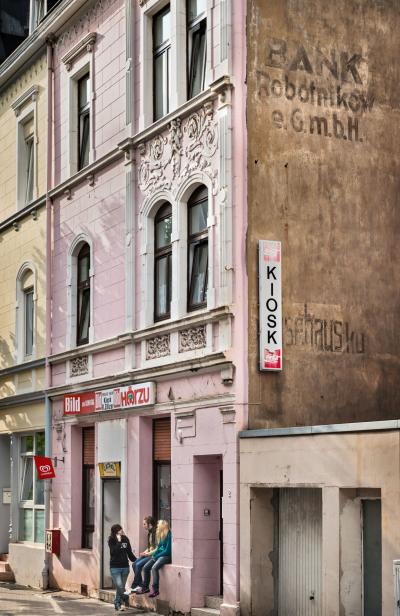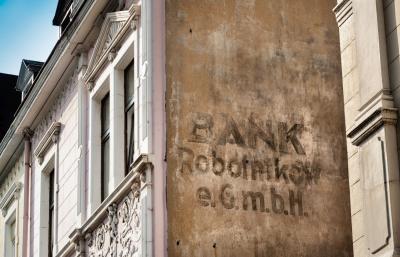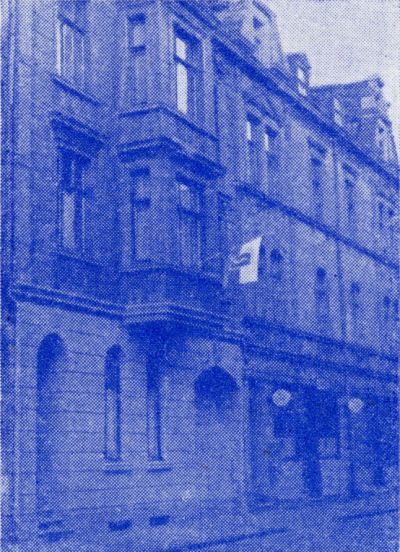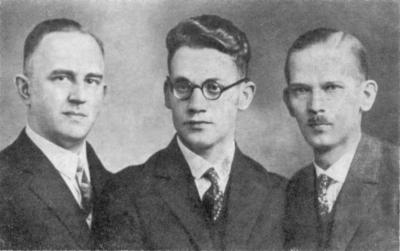About Polish miners, “Polish mines” and “Workers from the East” – A look back at 100 years of the history of Polish workers in Bochum (1871-1973)
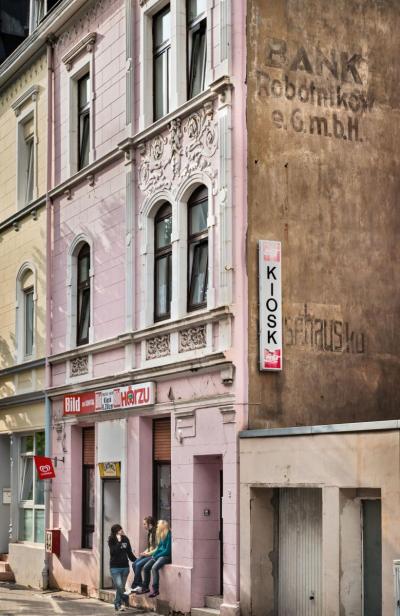
Introduction
According to the cult song Bochum by the singer Herbert Grönemeyer, the town “deep in the West” is “completely grey from work”, but that has not been the case for a long time now. Nevertheless, the mining and the economic and demographic change it brought with it remains a chapter that has left a deep imprint on Bochum's history. In the second half of the 19th century, with industrialisation rapidly developing in the Ruhr area, which was then known as the “Rhenish-Westphalian industrial region”, an important period of the Polish East-West internal migration began within the German Reich. The ethnic group of Polish-speaking Prussian nationals, collectively referred to as “Ruhr Poles”, migrated in large numbers from the eastern regions of what was then Prussia to what is today the Ruhr area, mainly to work in mining.
The fact that Bochum was once the cultural centre of these Polish workers is still evident in a few places in the city: In the street called Am Kortländer, a weathered inscription on a wall indicates the former existence of a Polish workers’ bank (see Fig. 1 & 2); in the Bochum district of Dahlhausen, an information board recalls the Polish economic migrants and their multi-faceted culture of associations during the time of the Empire (see Fig. 3); and today, in St. Joseph’s Church, the Polish Catholic mission in Bochum still offers pastoral care to the Polish-speaking Catholic community in the region, including holding regular masses (see Fig. 4 & 5). But Polish workers were not just to be found in Bochum and the Ruhr area during the period of industrialisation: they remained in the German Reich for many more decades, experienced the darkest chapter in German history, including working as forced labourers during the two world wars, and were also active in a number of different areas within the Federal Republic of Germany in the period after the war. They have been an established feature of Germany’s diverse society right up to the present day.
What was the history of Polish workers in Bochum like and what changes did they live through over the decades? This question forms the basis of the following article which looks back on a period of about 100 years – from the moment the Ruhr Poles began to migrate when the empire was founded in 1871 to the closure of the last mine in Bochum in 1973.
Industrialisation between the 19th and 20th century
From the second half of the 19th century, with the onset of industrialisation, the Ruhr area with its rich coal reserves experienced a great economic upturn. Bochum, with its mines Vereinigte Präsident, Constantin der Große, Hannover, Hannibal, Harpener Verein and Heinrich Gustav, was able to establish itself as the mining centre of the Ruhr area.[1] The boom in the coal and steel industry resulted in an increased demand for workers for the mining industry, both in Bochum and throughout the Rhenish-Westphalian coal region. This prompted mine owners to commission private agents who were to hire suitable workers for the mining industry. These workers were mainly to be found in the Polish-speaking population of the former eastern provinces of Prussia because of the favourable socio-economic baseline. Over time, targeted recruitment and word of mouth brought about chain migration, which developed into internal migration of a magnitude that had been hitherto unknown in the German empire. Between the founding of the empire in 1871 and the beginning of the First World War in 1914, over half a million people migrated from the eastern regions of Prussia to the Rhenish-Westphalian industrial region, which is now known as the Ruhr area. This group of economic migrants is known by the term “Ruhr Poles” because of their Polish origins and because they migrated to the Ruhr area.[2]
With the increase in workers, the population of Bochum grew continuously: Whilst 21,192 inhabitants were recorded in the city in 1871, this number grew to 57,601 in 1890 and to 65,551 in 1900. According to Prussian statistics, in 1890 people of Polish origin made up around 2.4 % of Bochum’s population, with a continued upward trend whose pinnacle was reached in 1910 when 4.6 % of Bochum’s population were Poles.[3] Over time, a kind of momentum of internal migration developed as families followed and more people were recruited by word of mouth from the Polish workers’ home towns: The Ruhr Poles typically settled in their destinations in the Rhenish-Westphalian industrial region based on the regions they came from. In terms of the Bochum region, it is apparent that an overwhelming majority of the Poles came from Eastern Prussia and from the province of Poznań.[4] The age and gender demographics of the Ruhr Poles show that it was predominantly men who migrated to the Ruhr area and the majority of them were between 20 and 30 years of age. By contrast, women made up a much smaller part of the economic migration, but they too were mostly represented by young women between 20 and 30 years of age who were able to work.[5]
In the main, men were employed to carry out particularly demanding physical work and mainly worked in mining and heavy industries. By contrast, the women usually looked after the household but also frequently took up work in the textile and cleaning industries. Both men and women were employed in the various areas involved in agricultural. What is more, women usually took on the role of organising lodgers, the so-called boarders. Most of the Polish workers lived close to the mines in colliery settlements built specifically to house them, and, over time, the sub-letting of rooms and beds became a steady sideline.[6]
[1] cf. Pätzold, Stefan: Bochum. Kleine Stadtgeschichte, p. 85.
[2] The group of Polish people, known collectively as the Ruhr Poles, came from the Prussian provinces of Poznań, East Prussia (including the Polish-speaking Protestants of Masuria), West Prussia, Silesia and southern Ermland;
Scientific research about the Ruhr Poles mainly focuses on male workers as they were the ones specifically recruited to work in the mining industry and were dominant in terms of numbers. Nevertheless, female migrants should also be mentioned at this point because women followed their menfolk to the Ruhr area with their families and also took up work there.
cf. Skrabania, David: Die Ruhrpolen, in: https://www.porta-polonica.de/de/atlas-der-erinnerungsorte/die-ruhrpolen?page=1#body-top.
[3] cf. Kleßmann, Christoph: Polnische Bergarbeiter im Ruhrgebiet 1870-1945. Soziale Integration und nationale Subkultur einer Minderheit in der deutschen Industriegesellschaft, p. 267;
Pätzold, Stefan: Bochum. Kleine Stadtgeschichte, p. 87.
[4] cf. Murzynowska, Krystyna: Die polnischen Erwerbsauswanderer im Ruhrgebiet während der Jahre 1880-1914, p. 47 f.
[5] In 1890, for every 100 men that migrated, 39.7 women migrated. This number grew as migration increased and families followed, so that in 1910 there were 76.8 women to every 100 men;
cf. Kleßmann, Christoph: Polnische Bergarbeiter im Ruhrgebiet 1870-1945. Soziale Integration und nationale Subkultur einer Minderheit in der deutschen Industriegesellschaft, p. 268;
cf. Murzynowska, Krystyna: Die polnischen Erwerbsauswanderer im Ruhrgebiet während der Jahre 1880-1914, p. 39.
[6] cf. Murzynowska, Krystyna: Die polnischen Erwerbsauswanderer im Ruhrgebiet während der Jahre 1880-1914, p. 51 f.
In the Bochum region, Polish workers were mainly used in mining and heavy industries. Some mines even became known as so-called Polish mines: One such mine was the Dannenbaum mine in the Bochum-Süd mining district because of the large proportion of Polish workers there, and many Poles were also registered at the coke plant at the Constantin der Große mine – in 1905, 88.2 % of the workers in the coke plant were of Polish origin.[7] A large number of Poles was also employed by the coal and steel industry group Bochumer Verein für Bergbau und Gussstahlfabrikation (see Fig. 6): In 1872/73, the first Slavic names were already being seen in the workforce and in 1889, 11.7 % of the workers at the Bochumer Verein were of Polish origin.[8]
As the years and decades passed, however, Bochum became increasingly important to Polish economic migrants, not just because of work, but also because it established itself as the heart of the cultural life of the Poles. “The fact that Bochum gradually evolved as the centre of the organised Ruhr Pole movement in the German Reich from the 1880s was a coincidence”[9], because in 1884 the spiritual leader Józef Szotowski was called to the position of chaplain at St. Peter’s rectory in Bochum. From that time on, he looked after the spiritual welfare of the Polish immigrants. From 1890, Franciszek Liss took over the office, and lived, like his predecessor, in the Redemptorist Monastery in Klosterstraße in Bochum and, from there, he administered to the needs of the growing Polish community in the Rhenish-Westphalian industrial region. It was Liss who founded the first Polish language magazine in the Ruhr area, Wiarus Polski, at the end of 1890. The publishing and printing house was located in Malteser Str. in the immediate vicinity of the Redemptorist Monastery in Klosterstraße. Other Polish organisations, such as the Polish worker’s bank (Bank Robotników) and the Union of Poles in Germany (Związek Polaków w Niemczech), which was founded in 1922 and still exists today, also established themselves here (which today is still in parts Klosterstraße and Am Kortländer), which led to the street being known as “Bochum Forge“.[10] The Polish Professional Association (Zjednoczenie Zawodowe Polskie), which was established in Bochum in 1902, also made its home there. The association had a miners’ department which can also be seen in the receipt book from 1913.
Because the organisation of the Ruhr Poles was focussed in one place, a Central Office for Monitoring the Movement of Poles in the Rhenish-Westphalian Industrial Region was established at the Police Headquarters in Bochum in 1909. The aim of the so-called “Pole monitoring centre” was to counter the actions of an allegedly subversive national ‘polishness’ and was, therefore, an expression of the widespread social discrimination and repressive measures by the state towards the Polish migrants which was rife at the time.[11] Within the labour force, the Ruhr Poles were frequently seen as wage squeezers and repeatedly had to face untold resentment from the native population who expressed their feelings through exclusion and hostility, in particular. The oppressive methods by the state included, for example, a systematic monitoring of Polish assemblies and the prohibition of marriages in the Polish language that had now been passed.[12] Not least because of the pressure of the restrictive measures imposed by Prussian authorities, over time the Ruhr Poles demonstrated an increasing willingness to integrate into the native German population, which, as the decades passed, also showed a tendency towards assimilation.[13]
[7] cf. Kleßmann, Christoph: Polnische Bergarbeiter im Ruhrgebiet 1870-1945. Soziale Integration und nationale Subkultur einer Minderheit in der deutschen Industriegesellschaft, p. 51.
[8] cf. Rudzinski, Marco: Ein Unternehmen und “seine” Stadt. Der Bochumer Verein und Bochum vor dem Ersten Weltkrieg, p. 103.
[9] Bleidick, Dietmar: Bochum, das institutionelle Zentrum der Polen in Deutschland, p. 4.
[10] cf. Bleidick, Dietmar: Bochum, das institutionelle Zentrum der Polen in Deutschland, p. 6.
[11] cf. Kleßmann, Christoph: Polnische Bergarbeiter im Ruhrgebiet 1870-1945. Soziale Integration und nationale Subkultur einer Minderheit in der deutschen Industriegesellschaft, p. 93;
cf. Stefanski, Valentina Maria: „… und bin sehr dankbar für die Gelegenheit an der Bekämpfung des Polenthums mitarbeiten zu können“. Polnische Arbeitsmigranten und die preußische Obrigkeit, p. 42 f.
[12] cf. Stefanski, Valentina Maria: „… und bin sehr dankbar für die Gelegenheit an der Bekämpfung des Polenthums mitarbeiten zu können“. Polnische Arbeitsmigranten und die preußische Obrigkeit, p. 38; p. 42 ff.
[13] cf. Skrabania, David: The Ruhr Poles, in: https://www.porta-polonica.de/de/atlas-der-erinnerungsorte/die-ruhrpolen?page=8#body-top.
The First World War and the interwar period
From the second half of the 19th century onwards, coal mining in the Ruhr continued to develop until the outbreak of war, which meant that the need for workers in mining and in steel production continued to increase – Bochum too, just like all the other mining districts in the Dortmund mining authority, recorded increasing numbers in the mine workforces.[14] However, from the start of the 20th century, more and more professions in trade and crafts, such as tailors, cobblers, midwives, painters and hairdressers, could be found within the population of Ruhr Poles.[15] Nevertheless, the majority of the Ruhr Poles remained employed in mining and in the iron and heavy industries.
With the outbreak of the First World War, however, there was a fundamental change to the increasing economic upturn. The general wartime mobilisation meant that most of the people in the workforce that were the right age for military service were conscripted. As early as autumn 1914, the mines and heavy industry factories, in particular, were already complaining of an immense shortage of workers, but especially of skilled workers.[16] In his comprehensive monograph on the war work of the town, the local Bochum politician and civil servant in the Municipal Authority, Paul Küppers, delivered an almost euphoric description of the town’s work situation during the First World War, despite the adverse circumstances:
“A resounding hammer blow is mixed with the whirring of machinery to form the fundamental sound in the great symphony of work. (…) In pure chords, the Bochum cast steel bells announce their praise for the industriousness of the local people (…) And whilst the battle raged outside, the ranks of those that had stayed at home united in the Westphalian way, tough and strong, to deal with the tasks in which the battle at the front is to be conducted victoriously. There, the coal that gives power and light was produced with twice as much zeal; there, the iron was stretched, there, the steel was annealed and turned into weapons of destruction (…).“[17]
On the one hand, this almost poetic representation of the work ethic of the Bochum workers in the coal and steel industry indicates the enthusiasm for the war which prevailed amongst some of the German population whilst, on the other hand, the foreign workers, who made up a significant part of the labour force, are completely left out of the description. But it was the Polish workers, in particular, who made a significant contribution to keeping the mining and arms industry going during the First World War.[18]
It was for this reason that more than half a million more Poles came to the German Reich as civilian workers and prisoners of war during the war so that they could be deployed in the arms and industry sectors that were so important to the wartime economy.[19] It is, however, difficult to quantify the number of forced labourers from Poland because the statistical information is missing.[20]
The period of the First World War was marked by a (compulsory) recruitment of foreign workers, including a large number from Poland. After the end of the war, many of these Polish workers left the borders of the German Reich again. With the re-establishing of the Polish state in 1918, not only did the workers who had been recruited during the war return to their homeland, but the Ruhr Poles that had been settled in the Rhenish-Westphalian industrial region for decades also migrated out of the Ruhr area in increasing numbers. Whilst part of this population of Ruhr Poles moved on in the hope of better work opportunities in the French and Belgium coal districts, around 150,000 Ruhr Poles returned to their regions of origin which, after 1918, belonged once again to the Polish state.[21]
[14] cf. Rawe, Kai: „…wir werden sie schon zur Arbeit bringen!“. Ausländerbeschäftigung und Zwangsarbeit im Ruhrkohlenbergbau während des Ersten Weltkrieges, p. 47;
cf. Küppers, Paul: Die Kriegsarbeit der Stadt Bochum 1914-1918, p. 47.
[15] cf. Murzynowska, Krystyna: Die polnischen Erwerbsauswanderer im Ruhrgebiet während der Jahre 1880-1914, p. 59 f.
[16] cf. Rawe, Kai: „…wir werden sie schon zur Arbeit bringen!“. Ausländerbeschäftigung und Zwangsarbeit im Ruhrkohlenbergbau während des Ersten Weltkrieges, p. 47;
cf. Küppers, Paul: Die Kriegsarbeit der Stadt Bochum 1914-1918, p. 263.
[17] Küppers, Paul: Die Kriegsarbeit der Stadt Bochum 1914-1918, p. 301 f.
[18] cf. Molenda, Jan: Polnische Arbeiter im Ruhrgebiet während des Ersten Weltkrieges, p. 198.
[19] cf. Rawe, Kai: „…wir werden sie schon zur Arbeit bringen!“. Ausländerbeschäftigung und Zwangsarbeit im Ruhrkohlenbergbau während des Ersten Weltkrieges, p. 155 f.
[20] According to current research, it can be assumed that between 14,000 and 16,000 Polish civilian workers were deployed in the Ruhr mining industry alone during the First World War. It is not possible to reliably determine how many prisoners of war and forced labourers there were or where they were deployed because not all enterprises documented their deployment equally. Their number may, however, have been considerably higher than that of the civilian workers;
cf. Molenda, Jan: Polnische Arbeiter im Ruhrgebiet während des Ersten Weltkrieges, p. 185.
[21] cf. Skrabania, David: Die Ruhrpolen, in: https://www.porta-polonica.de/de/atlas-der-erinnerungsorte/die-ruhrpolen?page=9#body-top.
National Socialism and the Second World War
During the Second World War, the National Socialists’ war economy drew a large part of their workers from the foreign workforce, just like in the period between 1914 and 1918. Research today shows that during the course of the Second World War in the territory of the so-called Greater German Reich, around 13.5 million people were forced into labour for Nazi Germany, 2.8 million of whom were Poles.[22] The workers were assigned to forced labour in all areas of economic life, such as agriculture and forestry, mining, the (arms) industry, but also in trades or private households. The Ruhr area, with its rich coal reserves, was “(…) a central segment of the Nazi war economy”[23] (see Fig. 7).
In Bochum, it is thought that, during the course of the Second World War, there were over 30,000 forced labourers of different nationalities, including many Poles.[24] The forced labourers were housed in around 100 different, smaller and larger forced labour camps and barracks which were spread throughout the entire city area. Polish forced labourers were also housed in many of these camps. The Bergen camp, for example, which was set up in 1941 and 1942 for the civilian workers at the Constantin mine, is said to have accommodated around 600 people during the war, most of whom were conscripted Poles and Galicians (see Fig. 8 & 9).[25] Until 1943, forced labourers were mainly housed in wooden barracks, but bombing raids “(...)proved them inadequate as they were highly flammable“[26], as a result of which the Reich Ministry for Armament and Ammunition ordered them to be built from solid construction materials. In terms of numbers, the greatest deployment of forced labourers in Bochum was in the coal and steel companies of the Bochumer Verein which had been known as a “Nazi model company” since 1937[27] and was a linchpin of the war economy because it produced important war material for the Wehrmacht, Luftwaffe and the navy.[28]
Just like in the First World War, the Bochum Verein had to provide some of its male workers for military service when Poland was invaded on 1 September 1939. This meant that many jobs in the coal and steel industry remained vacant and, from 1940, were increasingly filled by foreign workers.[29] In June 1944, a subcamp of Buchenwald concentration camp was even set up at the Bochum Verein to take around 2,000 concentration camp prisoners and was overseen by the SS (See Fig. 10).[30] It was situated in the west of Bochum in Brüllstraße on the Bochum Verein factory site between Kohlenstraße and Alleestraße and so was in the direct proximity of armament and ammunition factories. The camp comprised 17 barracks and was fenced in with watchtowers and electric power lines. The concentration camp prisoners were mainly used as forced labour for the building and earthworks in the camp or in the nearby projectile factory, working in two 12-hour shifts. The factory mainly produced ammunition and, in the attached header shop, the concentration camp prisoners were put to work on the so-called monster presses on which smouldering iron blocks were processed. The prisoners were not given any protective clothing at all for the heavy work and often suffered severe burns as a result.[31]
[22] The foreign workers deployed in Nazi Germany during the Second World War can be broken down into the following three groups: Firstly, civilian workers. Secondly, prisoners of war, thirdly, prisoners from work education camps and concentration camps.
cf. Spoerer, Mark: Zwangsarbeit unter dem Hakenkreuz: ausländische Zivilarbeiter, Kriegsgefangene und Häftlinge im Deutschen Reich und im besetzten Europa 1939-1945, p. 9 ff., p. 90 ff.
[23] Seidel, Hans-Christoph: Der Ruhrbergbau im Zweiten Weltkrieg. Zechen – Bergarbeiter – Zwangsarbeiter, p. 21.
[24] cf. Grieger, Manfred: Zwangsarbeit in Bochum – Die Geschichte der ausländischen Arbeiter und KZ-Häftlinge 1939-1945, p. 4.
[25] cf. https://www.bochum.de/Denkmalschutz-/-Denkmalpflege/Denkmalliste-der-Stadt-Bochum/Siedlungen/Bergener-Strasse;
[26] Letter from the Ruhr Essen Regional Mining Industry Group to the Bochum Group dated 29 May 1943: Re: Barracks, in: Montanhistorisches Dokumentationszentrum (montan.dok) at the Deutsches Bergbau-Museum Bochum/Mining Archive (BBA) 40/487.
[27] On 1 May 1937, the Bochum Verein, as one of 30 operations and the only company from the coal and steel industry, was awarded the title “Nazi model company” by the so-called “Beauty of Labour” office which was overseen by the German Labour Front;
cf. Seebold, Gustav-Hermann: Ein Stahlkonzern im Dritten Reich. Der Bochumer Verein 1927-1945, p.255 f.
[28] In total, more than 10,000 people were forced into labour for the Bochum Verein and were spread over 15 camps belonging to the company. The forced labourers were involved in the production of various war materials, such as projectiles, grenades, artillery or various tank parts;
cf. Gleising, Günter: Bochums Stellung in der Rüstungs- und Kriegswirtschaft unter besonderer Berücksichtigung des Bochumer Vereins und dessen Zwangsarbeitereinsatz, p. 32 f., p. 35 f.
[29] cf. Seebold, Gustav-Hermann: Ein Stahlkonzern im Dritten Reich. Der Bochumer Verein 1927-1945, p. 159.
[30] The camp was in use from June 1944 until it was closed down in March 1945 as the allied troops approached Bochum. The Obersturmführer of the Waffen SS Hermann Großmann held the position of SS head of the subcamp in Bochum. At the end of the war, during a process targeting perpetrators from Buchenwald concentration camp, he was sentenced to death by the US military court and executed in Landsberg am Lech in 1948;
cf. Wölk, Ingrid: Das Außenlager des Konzentrationslagers Buchenwald beim ‘Bochumer Verein’, p. 50 f.
[31] cf. Wölk, Ingrid: Das Außenlager des Konzentrationslagers Buchenwald beim ‘Bochumer Verein’, p. 47.
Polish forced labourers are mentioned repeatedly in the sources and eye-witness accounts of the Nazi forced labour in Bochum. Evidence of Polish prisoners can be found in the first prisoner transport which went from Auschwitz concentration and extermination camp via Buchenwald before arriving in Bochum on 21 June 1944 with 446 people on board.[32] Eye-witness accounts mention Polish forced labourers both in grenade and bomb production, which was carried out by female forced labourers, and in the deployment of foreign workers in the projectile pressing shop in Stahlhausen.[33] Just what draconian punishments those forced into labour for the Nazis had to suffer in Bochum can be seen from the fate of a Polish farm labourer in Wattenscheid: He was hanged because he is said to have made advances to a citizen of the German Reich.[34] According to a report from the President of the District Court in Bochum of 20 June 1941, the execution is also said to have taken place in public in the presence of all the Polish forced labourers.[35]
Overall, the forced labourers deployed in Bochum suffered difficult, even sometimes slave-like working conditions as well as inhumane living conditions in most of the camps. Confidential documents from Bochum employment office reveal that inspections of the forced labourers’ accommodation and working conditions were able to identify repeated abuse, poor sanitation, insufficient food, and increased spread of disease.[36] The difficult working and living conditions resulted in the forced labourers suffering from malnutrition, diseases and physical and mental debilitation which caused countless deaths, both in the short term and over the long term. In addition, many forced labourers perished as a result of draconian punishments, including the death sentence. Because of the number of unrecorded cases, an exact figure cannot be placed on the actual number of fatalities resulting from forced labour under the Nazis. Of the 1,720 victims of forced labour who were buried in Bochum Freigrafendamm cemetery, 78 were of Polish origin.[37]
[32] Hungarian, Czech, Russian and Polish prisoners were also included in this first transport, many of them were Jews;
cf. Wölk, Ingrid: Das Außenlager des Konzentrationslagers Buchenwald beim ‚Bochumer Verein‘, p. 44.
[33] cf. Gleising, Günter: Bochums Stellung in der Rüstungs- und Kriegswirtschaft unter besonderer Berücksichtigung des Bochumer Vereins und dessen Zwangsarbeitereinsatz, p. 37 f.
[34] According to Nazi ideology, Poles were far down the “racial hierarchy” of the National Socialists; this applied to forced labourers as well. On 8 March 1940, the so-called Polish decrees came into force which defined a series of policies discriminating against Polish forced labourers, including the compulsory labelling of workers with a “P”, as well as a ban on Poles being in contact with the German population;
cf. Loew, Peter Oliver: Das Zeichen „P“, at: https://www.porta-polonica.de/de/atlas-der-erinnerungsorte/das-zeichen-p?page=1#body-top.
[35] cf. Grieger, Manfred: Zwangsarbeit in Bochum – Die Geschichte der ausländischen Arbeiter und KZ-Häftlinge 1939-1945, p. 4.
[36] cf. Bochum employment office from 14 July 1943: To all operators that employ foreign workers. Re: Abuse of foreign workers, in: montan.dok/BBA 40/492;
cf. Bochum employment office from 31 May 1944: To all companies that employ foreign workers. Re: Accommodating foreign workers, in: montan.dok/BBA 40/487.
[37] cf. municipal archive – Centre for local history in Bochum (publ.): "Wir gedenken der Opfer der Zwangsarbeit in Bochum, 1941 bis 1945, Letzte Ruhestätte:Hauptfriedhof Freigrafendamm". Edited and compiled by Ursula Jennemann-Henke, with the assistance of Angelika Karg and Angelika Schäfer – Municipal archive, Bochum 2002.
Post-war period and outlook
“The Nazi dictatorship, night-time air raids and fear of death were over, but the hardship and suffering of the people were not”[38]: When Bochum was placed under British control on 12 April 1945, 90% of the city centre had been destroyed. Denazification, clearing of rubble and the lack of essential supplies were just some of the many challenges that the people of Bochum had to face after the end of the war. But the economy was able to be revived quickly – 1957 went down in history as the record year of the economic miracle of the post-war years. However, in the 1960s the tide turned – with coal being increasingly replaced by the energy sources natural gas and oil, the mines started to be gradually closed down. The Bochum mines, which had left such a lasting impression on the town’s history over the past 100 years, were closed one after the other until the Hannover mine in the suburb of Hordel was the last to close in 1973. [39]
And the (Ruhr) Poles? In the 100-year period that has been discussed here, they established themselves as a permanent fixture in Bochum’s history as a city and as a place to work. They migrated to the Ruhr area as Prussian citizens, whose language and nationality were Polish, and they played a significant role in the region’s economic recovery. Traces of the Ruhr Poles’ labour migration can still be seen in Bochum today: Some of the old miner’s settlements, where Polish migrants also lived, still exist today – these include the Dahlhauser Heide colony in Hordel (see Fig. 11 & 12) where Porta Polonica is housed in one of the listed workers’ houses (see Fig. 13). The former Hanover mine is now one of the sites for the Westphalian State Museum of Industrial Culture (see Fig. 14), whose work as a museum focuses here primarily on labour migration in the 19th century and casts a spotlight on the internal migration of the Ruhr Poles. In the two world wars, many Poles were forcibly deployed to work in the wartime and armaments economy, largely under devastating and inhumane conditions.
Although a large number of Polish workers left the German borders, a considerable proportion of them stayed in Germany and also in Bochum. After the end of the Second World War, the city found itself home not just to the Ruhr Poles and the next generations but also to the Polish workers who had been deployed in the war. Directly after the war, they were given the status of so-called “Displaced Persons” (DPs for short) – whilst some of them returned to their homeland, some of the DPs remained in Germany permanently.
In the period after the war, the Polish community in Bochum continued to grow, particularly as a result of the migratory movements of (later) emigrants. If you look in the phone book, amongst the population of Bochum, just like in the rest of the Ruhr area, you will find a variety of family names ending in -ski, -cki, -rek or -czyk indicating Polish genealogy. As well as Polish shops, like the SMAK supermarket in Laer or Nasza Biedronka in Wattenscheid, Polish religious life is still active in the city today and is organised by the Polish Catholic Mission in Bochum in St. Joseph’s church. The emergence of a Polish cultural life is also evident, as can been seen from the example of the artist group Kosmopolen founded in Bochum in 2008. When Porta Polonica, the Documentation Centre for the Culture and History of Poles in Germany, was established, which began its work as a federal project run by the Landschaftsverbandes Westfalen-Lippe [Regional Council of Westphalia and Lippe] (LWL) in 2013, a central institution for documenting and researching Polish life in Germany as part of the culture of remembrance made its home Bochum.
In the 100-year period that has been outlined in this article, Polish labour migration has been involved in various developments in Bochum’s history – most notably economic developments. Today, the Poles and the descendants of the Polish labour migrants are a permanent part of the population of Bochum and will continue to enrich the cultural and economic life of the city in the future.
Finally, a special thank you goes to Ms Maria Schäpers and the Montanhistorisches Dokumentationszentrum/mining archive in Bochum for providing documents.
Natalia Kubiak, January 2021
[38] Pätzold, Stefan: Bochum. Kleine Stadtgeschichte, p. 134.
[39] cf. Pätzold, Stefan: Bochum. Kleine Stadtgeschichte, p. 141.
List of sources and references:
Bleidick, Dietmar: Bochum, das institutionelle Zentrum der Polen in Deutschland, in: Kortum-Gesellschaft Bochum e.V. (publ.), Bochumer Zeitpunkte. Beiträge zur Stadtgeschichte, Heimatkunde und Denkmalpflege (33), Bochum 2015, p. 3-9.
Gleising, Günter: Bochums Stellung in der Rüstungs- und Kriegswirtschaft unter besonderer Berücksichtigung des Bochumer Vereins und dessen Zwangsarbeitereinsatz, in: Vereinigung der Verfolgten des Naziregimes – Bund der Antifaschistinnen und Antifaschisten (VVN-BdA) Kreisvereinigung Bochum, RuhrEcho Verlag, Bochum 2019, p. 23-40.
Grieger, Manfred: Zwangsarbeit in Bochum – Die Geschichte der ausländischen Arbeiter und KZ-Häftlinge 1939-1945, Bochum 1986.
Gusowski, Adam / Krämer, Sabine: Bochumer Schmiede, at: https://www.porta-polonica.de/de/atlas-der-erinnerungsorte/bochumer-schmiede, last accessed on 18/10/2020.
Kleßmann, Christoph: Polnische Bergarbeiter im Ruhrgebiet 1870-1945. Soziale Integration und nationale Subkultur einer Minderheit in der deutschen Industriegesellschaft, Vandenhoeck & Ruprecht, Göttingen 1978.
Küppers, Paul: Die Kriegsarbeit der Stadt Bochum 1914-1918, Buchdruckerei Wilhelm Stumpf K.-G., Bochum 1926.
Molenda, Jan: Polnische Arbeiter im Ruhrgebiet während des Ersten Weltkrieges, in: Dahlmann, Dittmar / Kotowski, Albert p. / Karpus, Zbigniew (publ.), Schimanski, Kuzorra und andere. Polnische Einwanderer im Ruhrgebiet zwischen der Reichsgründung und dem Zweiten Weltkrieg, Klartext Verlag, Essen 2005, p. 183-199.
Montanhistorisches Dokumentationszentrum/mining archive: 40/487, 40/492.
Murzynowska, Krystyna: Die polnischen Erwerbsauswanderer im Ruhrgebiet während der Jahre 1880-1914, Dortmund 1979.
Pätzold, Stefan: Bochum. Kleine Stadtgeschichte, Verlag Friedrich Pustet, Regensburg 2017.
Peters-Schildgen, Susanne: Das polnische Vereinswesen in der Kaiserzeit und in der Weimarer Republik. A comparison in: Dahlmann, Dittmar / Kotowski, Albert p. / Karpus, Zbigniew (publ.), Schimanski, Kuzorra und andere. Polnische Einwanderer im Ruhrgebiet zwischen der Reichsgründung und dem Zweiten Weltkrieg, Klartext Verlag, Essen 2005, p. 51-72.
Rawe, Kai: “… wir werden sie schon zur Arbeit bringen!”. Ausländerbeschäftigung und Zwangsarbeit im Ruhrkohlenbergbau während des Ersten Weltkrieges, Klartext Verlag, Essen 2005.
Rudzinski, Marco: Ein Unternehmen und ‘seine’ Stadt. Der Bochumer Verein und Bochum vor dem Ersten Weltkrieg, Klartext Verlag, Essen 2012.
Seebold, Gustav-Hermann: Ein Stahlkonzern im Dritten Reich. Der Bochumer Verein 1927-1945, Peter Hammer Verlag, Wuppertal 1981.
Seidel, Hans-Christoph: Der Ruhrbergbau im Zweiten Weltkrieg. Zechen – Bergarbeiter – Zwangsarbeiter, Klartext Verlag, Essen 2010.
Skrabania, David: The Ruhr Poles, at: https://www.porta-polonica.de/de/atlas-der-erinnerungsorte/die-ruhrpolen, last accessed on 23/10/2020.
Spoerer, Mark: Zwangsarbeit unter dem Hakenkreuz: ausländische Zivilarbeiter, Kriegsgefangene und Häftlinge im Deutschen Reich und im besetzten Europa 1939-1945, Deutsche Verlags-Anstalt, Stuttgart / München 2001.
Municipal archive – Bochum local history centre (publ.): "Wir gedenken der Opfer der Zwangsarbeit in Bochum, 1941 bis 1945, Letzte Ruhestätte: Hauptfriedhof Freigrafendamm". Edited and compiled by Ursula Jennemann-Henke, with the assistance of Angelika Karg and Angelika Schäfer – Municipal archive, Bochum 2002.
Stefanski, Valentina Maria: “… und bin sehr dankbar für die Gelegenheit an der Bekämpfung des Polenthums mitarbeiten zu können”. Polnische Arbeitsmigranten und die preußische Obrigkeit, in: Dahlmann, Dittmar / Kotowski, Albert p. / Karpus, Zbigniew (publ.), Schimanski, Kuzorra und andere. Polnische Einwanderer im Ruhrgebiet zwischen der Reichsgründung und dem Zweiten Weltkrieg, Klartext Verlag, Essen 2005, p. 37-49.
Wölk, Ingrid: Das Außenlager des Konzentrationslagers Buchenwald beim ‚Bochumer Verein‘, in: Vereinigung der Verfolgten des Naziregimes – Bund der Antifaschistinnen und Antifaschisten (VVN-BdA) Kreisvereinigung Bochum, RuhrEcho Verlag, Bochum 2019, p. 41-54.
Additional literature on the history of Polish labour and migration in Bochum, in the Ruhr area and in Germany:
Dahlmann, Dittmar / Kotowski, Albert p. / Karpus, Zbigniew (publ.), Schimanski, Kuzorra and others. Polnische Einwanderer im Ruhrgebiet zwischen der Reichsgründung und dem Zweiten Weltkrieg, Klartext Verlag, Essen 2005.
Loew, Peter Oliver: Wir Unsichtbaren. Geschichte der Polen in Deutschland, Verlag C.H. Beck, München 2014.
Schade, Wulf: Kuźnia Bochumska – die Bochumer (Kader-)Schmiede, in: Bochumer Zeitpunkte. Beiträge zur Stadtgeschichte, Heimatkunde und Denkmalpflege 2005, Nr. 17, p. 3-21.
Skrabania, David: Keine Polen? Bewusstseinsprozesse und Partizipationsstrategien unter Ruhrpolen zwischen der Reichsgründung und den Anfängen der Weimarer Republik, Bochum 2018.
Smechowski, Emilia: Wir Strebermigranten, Carl Hanser Verlag, München 2017.
Additional Internet links relating to the local appraisal of forced labour under the Nazis in Bochum
https://www.kohlengraeberland.de
http://zwangsarbeiterprojekt.de
https://www.bochum.de/Stadtarchiv/Bochum-in-der-NS-Zeit
All Internet links given in the list of sources and references were last accessed on 9/1/2021.
